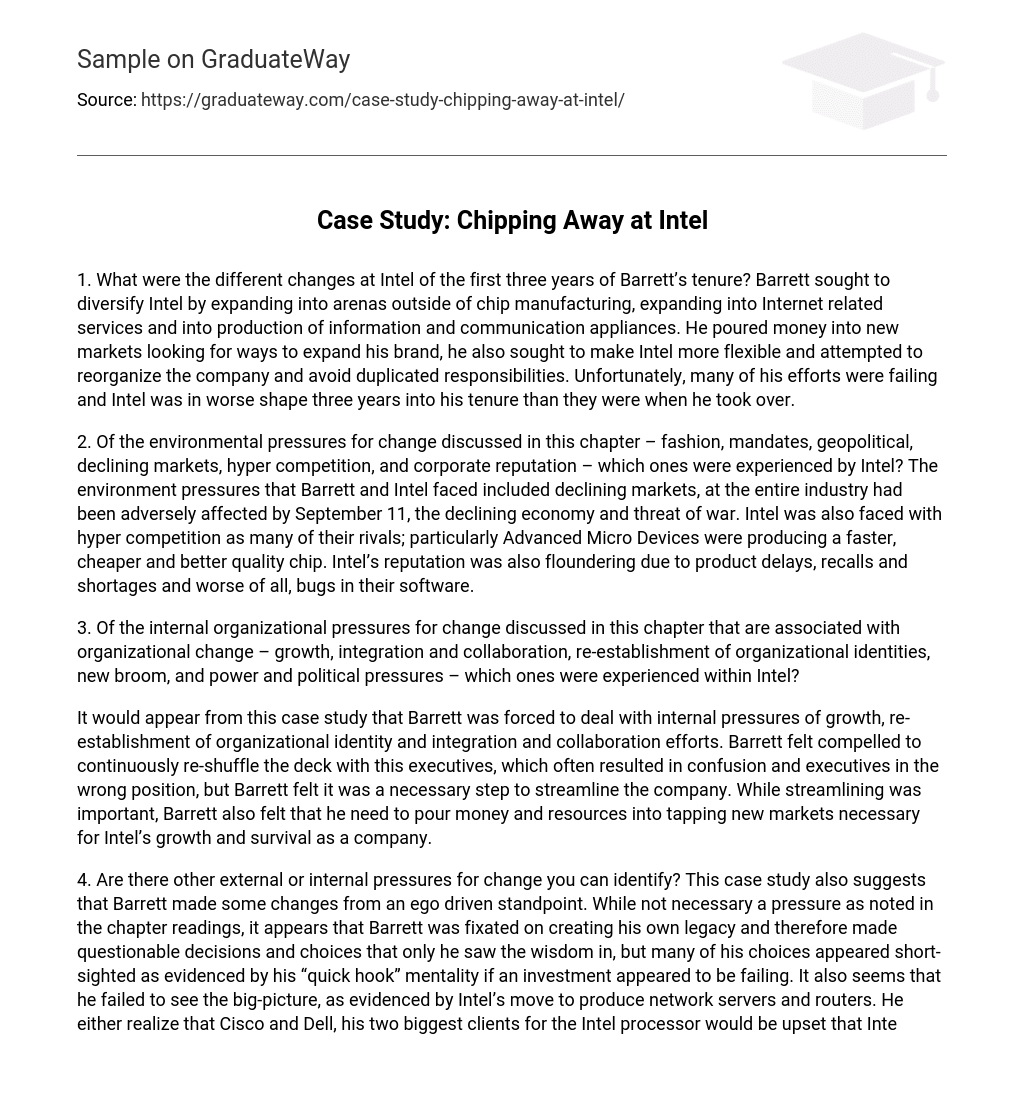1. What were the different changes at Intel of the first three years of Barrett’s tenure? Barrett sought to diversify Intel by expanding into arenas outside of chip manufacturing, expanding into Internet related services and into production of information and communication appliances. He poured money into new markets looking for ways to expand his brand, he also sought to make Intel more flexible and attempted to reorganize the company and avoid duplicated responsibilities. Unfortunately, many of his efforts were failing and Intel was in worse shape three years into his tenure than they were when he took over.
2. Of the environmental pressures for change discussed in this chapter – fashion, mandates, geopolitical, declining markets, hyper competition, and corporate reputation – which ones were experienced by Intel? The environment pressures that Barrett and Intel faced included declining markets, at the entire industry had been adversely affected by September 11, the declining economy and threat of war. Intel was also faced with hyper competition as many of their rivals; particularly Advanced Micro Devices were producing a faster, cheaper and better quality chip. Intel’s reputation was also floundering due to product delays, recalls and shortages and worse of all, bugs in their software.
3. Of the internal organizational pressures for change discussed in this chapter that are associated with organizational change – growth, integration and collaboration, re-establishment of organizational identities, new broom, and power and political pressures – which ones were experienced within Intel?
It would appear from this case study that Barrett was forced to deal with internal pressures of growth, re-establishment of organizational identity and integration and collaboration efforts. Barrett felt compelled to continuously re-shuffle the deck with this executives, which often resulted in confusion and executives in the wrong position, but Barrett felt it was a necessary step to streamline the company. While streamlining was important, Barrett also felt that he need to pour money and resources into tapping new markets necessary for Intel’s growth and survival as a company.
4. Are there other external or internal pressures for change you can identify? This case study also suggests that Barrett made some changes from an ego driven standpoint. While not necessary a pressure as noted in the chapter readings, it appears that Barrett was fixated on creating his own legacy and therefore made questionable decisions and choices that only he saw the wisdom in, but many of his choices appeared short-sighted as evidenced by his “quick hook” mentality if an investment appeared to be failing. It also seems that he failed to see the big-picture, as evidenced by Intel’s move to produce network servers and routers. He either realize that Cisco and Dell, his two biggest clients for the Intel processor would be upset that Intel was now trying to rival their technology or his ego lead him to believe that Intel could and would surpass his clients on their way to global domination in the marketplace.
5. What overall conclusions do you draw about why Barrett made the changes he did? Which issues were dominant? Why? Personally, I believe that Barrett may have been influenced by the accomplishments of his predecessors. He inherited his position at Intel on the heels of Andrew Grove, who had successfully navigated Intel into a major global company, and of Gordon More who had doubled Intel’s performance every eighteen months while making things cheaper. Barrett may have felt his risky moves where necessary if he wanted to keep pace with established legends. The dominant issues during his tenure where that of an economic decline and increased competition, he also felt the need to change the corporate culture towards better customer relations as a way to make Intel more consumer driven. It would appear from this case study that some of the strategic moves Barrett made were unnecessary.
6. What pressures for change might Barrett face in the future? How do you arrive at this assessment? Barrett is going to continue to face competition in the marketplace and if Intel does not show improvement there is likely to
be members of the Board of Directors, stockholders and employees questioning his position as CEO, additionally if competitors continue to see Intel’s position slipping, they will increase efforts to pull farther ahead of Intel. Given Barrett’s three-year track record, it is likely that he will continue to try and push into new markets, which will be quite risky in the economic environment Intel currently faces.
7. What advice would you give Barrett for how to cope with these change pressures? Barrett will need to stay the course and lean on advisors and consultants to aid in his decision making. If he feels that Intel needs to diversify to stay profitable, then he’ll need to make commitments in his reorganizational efforts and investment strategies. Changing direction every few months will not yield the stable, cultural changes that he desires to make. His investments in research and new production efforts will be paramount to Intel’s success and he will need to position himself and his image as that of a strong, decisive leader.





